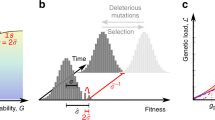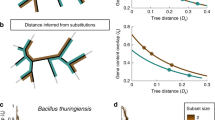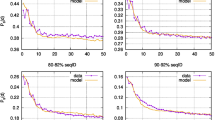Abstract
THE mechanism by which coincidental or horizontal evolution occurs in the multigene families (such as ribosomal RNA genes) represents one of the most challenging problems of molecular evolution1,2. Smith3 and Black and Gibson4 put forward an elegant model of coincidental evolution, assuming homologous but unequal crossing over. They have shown, using computer simulations, that repeated unequal crossing over results in the gradual loss of gene lineages, and that eventually the whole family becomes fixed by a single gene lineage. Here the population dynamics of gene lineages within a multigene family is analogous to the population dynamics of mutant genes within a finite Mendelian population. In this communication I show that a quantitative theory of unequal crossover fixation can be developed based on the mathematical theory of population genetics5,6, treating the behaviour of mutant alleles in finite populations.
This is a preview of subscription content, access via your institution
Access options
Subscribe to this journal
Receive 51 print issues and online access
$199.00 per year
only $3.90 per issue
Buy this article
- Purchase on Springer Link
- Instant access to full article PDF
Prices may be subject to local taxes which are calculated during checkout
Similar content being viewed by others
References
Hood, L. E., Wilson, J. H., and Wood, W. B., Molecular Biology of Eucaryotic Cells (Benjamin, Menlo Park, 1975).
Hood, L., Campbell, J. H., and Elgin, S. C. R., A. Rev. Genet., 9, 305–353 (1975).
Smith, G. P., Cold Spring Harb. Symp. quant. Biol., 38, 507–513 (1974).
Black, J. A., and Gibson, D., Nature, 250, 327–328 (1974).
Crow, J. F., and Kimura, M., An Introduction to Population Genetics Theory (Harper and Row, New York, 1970).
Kimura, M., and Ohta, T., Theoretical Aspects of Population Genetics (Princeton University Press, Princeton, 1971).
Kimura, M., J. appl. Probability, 1, 177–232 (1964).
Kimura, M., and Ohta, T., Genetics, 61, 763–771 (1969).
Kimura, M., and Ohta, T., Genetics, 63, 701–709 (1969).
Maruyama, T., and Kimura, M., Jap. J. Genet., 46, 407–410 (1971).
Author information
Authors and Affiliations
Rights and permissions
About this article
Cite this article
OHTA, T. Simple model for treating evolution of multigene families. Nature 263, 74–76 (1976). https://doi.org/10.1038/263074a0
Received:
Accepted:
Issue Date:
DOI: https://doi.org/10.1038/263074a0
This article is cited by
-
Population genetic models of duplicated genes
Genetica (2009)
-
Intraspecific 5S rRNA gene variation in flax,Linum usitatissimum (Linaceae)
Plant Systematics and Evolution (1992)
-
Heterogeneity and organization of the ribosomal RNA genes ofCucurbita maxima
Plant Molecular Biology (1990)
-
Unequal crossing over in the ribosomal DNA of Saccharomyces cerevisiae
Nature (1980)
-
Amino acid diversity of immunoglobulins as a product of molecular evolution
Journal of Molecular Evolution (1980)
Comments
By submitting a comment you agree to abide by our Terms and Community Guidelines. If you find something abusive or that does not comply with our terms or guidelines please flag it as inappropriate.



